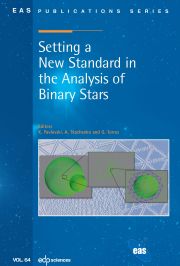Crossref Citations
This article has been cited by the following publications. This list is generated based on data provided by Crossref.
Rajagopal, Jayadev K.
Creech-Eakman, Michelle J.
Malbet, Fabien
Richardson, Noel D.
Moffat, Anthony F. J.
Maltais-Tariant, Raphael
Pablo, Herbert
Gies, Douglas R.
St-Louis, Nicole
Schaefer, Gail
Miroshnichenko, Anatoly S.
Farrington, Chris
Aldoretta, Emily J.
Artigau, Etienne
Boyajian, Tabetha
Gordon, Katie
Goldfinger, P. J.
Jones, Jeremy
Matson, Rachel
McAlister, Harold A.
O'Brien, David
Raghavan, Deepak
Ramiaramanantsoa, Tahina
Ridgway, Stephen T.
Scott, Nic
Sturmann, Judit
Sturmann, Laszlo
ten Brummelaar, Theo
Thomas, Joshua D.
Turner, Nils
Vargas, Norm
and
Zharikov, Sergey
2014.
MWC 314: binary results from optical interferometry compared with spectroscopy and photometry.
Vol. 9146,
Issue. ,
p.
91460G.
Pablo, Herbert
Richardson, Noel D.
Moffat, Anthony F. J.
Corcoran, Michael
Shenar, Tomer
Benvenuto, Omar
Fuller, Jim
Nazé, Yaël
Hoffman, Jennifer L.
Miroshnichenko, Anatoly
Apellániz, Jesús Maíz
Evans, Nancy
Eversberg, Thomas
Gayley, Ken
Gull, Ted
Hamaguchi, Kenji
Hamann, Wolf-Rainer
Henrichs, Huib
Hole, Tabetha
Ignace, Richard
Iping, Rosina
Lauer, Jennifer
Leutenegger, Maurice
Lomax, Jamie
Nichols, Joy
Oskinova, Lida
Owocki, Stan
Pollock, Andy
Russell, Christopher M. P.
Waldron, Wayne
Buil, Christian
Garrel, Thierry
Graham, Keith
Heathcote, Bernard
Lemoult, Thierry
Li, Dong
Mauclaire, Benjamin
Potter, Mike
Ribeiro, Jose
Matthews, Jaymie
Cameron, Chris
Guenther, David
Kuschnig, Rainer
Rowe, Jason
Rucinski, Slavek
Sasselov, Dimitar
and
Weiss, Werner
2015.
A COORDINATED X-RAY AND OPTICAL CAMPAIGN OF THE NEAREST MASSIVE ECLIPSING BINARY,δORIONIS Aa. III. ANALYSIS OF OPTICAL PHOTOMETRIC (MOST) AND SPECTROSCOPIC (GROUND-BASED) VARIATIONS.
The Astrophysical Journal,
Vol. 809,
Issue. 2,
p.
134.
Tkachenko, A.
Matthews, J. M.
Aerts, C.
Pavlovski, K.
Pápics, P. I.
Zwintz, K.
Cameron, C.
Walker, G. A. H.
Kuschnig, R.
Degroote, P.
Debosscher, J.
Moravveji, E.
Kolbas, V.
Guenther, D. B.
Moffat, A. F. J.
Rowe, J. F.
Rucinski, S. M.
Sasselov, D.
and
Weiss, W. W.
2016.
Stellar modelling of Spica, a high-mass spectroscopic binary with a β Cep variable primary component.
Monthly Notices of the Royal Astronomical Society,
Vol. 458,
Issue. 2,
p.
1964.
Tkachenko, A.
Tsymbal, V.
Zvyagintsev, S.
Lehmann, H.
Petermann, F.
and
Mkrtichian, D. E.
2022.
Pushing least-squares deconvolution to the next level: Application to binary stars.
Astronomy & Astrophysics,
Vol. 666,
Issue. ,
p.
A180.

